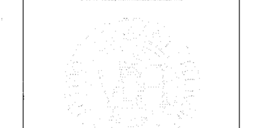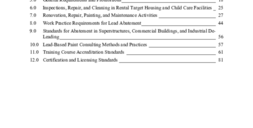Asbestos and Lead Requirements for Property Owners and Landlords
The information on this page is for property owners such as homeowners, landlords, rental property owners, property managers, and commercial building owners.
Asbestos and lead pose health risks, and they may be found in buildings and other structures. Because of this, the Health Department and the Environmental Protection Agency have specific requirements for the maintenance, renovation and demolition of buildings and other structures.
Asbestos-containing materials are only dangerous when they are disturbed or handled incorrectly. If asbestos-containing materials are not handled properly, asbestos particles can be breathed in. Even a small amount of asbestos-containing materials can cause health effects. Learn more about the hazards and health effects of asbestos.
Lead-based paint becomes a hazard when it is disturbed. This can be from chipping and peeling paint, when painted surfaces rub together, or when the paint is not properly sanded, scraped or burned. If lead-based paint is not handled properly, lead dust can be breathed in or swallowed by workers and by people, especially children, who use the building or other structure. Learn more about the hazards and health effects of lead.
What You Need to Know About Asbestos and Lead Requirements
Asbestos
For Homeowners
The Health Department recommends that you have an asbestos inspection performed:
- Before beginning a renovation
- If there is damage such as crumbling drywall or insulation that is falling apart
Disturbed or damaged asbestos-containing materials are a health hazard. Even newer buildings can have asbestos-containing materials. Places where asbestos is found in homes include insulation, joint compound, drywall, popcorn ceilings, ceiling and floor tiles, roofing shingles and siding, and other materials. A licensed asbestos inspector will know which materials to test for asbestos.
If asbestos-containing materials are found in your home, the Health Department recommends that you hire a licensed asbestos abatement company to remove the materials if they will be disturbed during a renovation or are damaged. Asbestos-containing materials that are in good condition can safely remain in place as long as they remain undamaged. Learn more about protecting your family form exposure to asbestos.
If you choose to remove the asbestos-containing materials yourself, you can do this in your own home. However, you are required to follow the methods for handling and disposing of asbestos-containing materials (see Section 1.1.6). Unsafe handling of asbestos-containing materials often leads to the need for asbestos cleanup by a Vermont-licensed asbestos contractor. For questions on safe handling and removal of asbestos-containing materials, please email [email protected].
If you hire an asbestos contractor, the contractor must be licensed by the State of Vermont and follow all required work practices.
For Owners of Rental, Public or Commercial Buildings
- Before renovating a building, an inspection is required and must be conducted by a Vermont-certified asbestos inspector.
- Follow all asbestos-related requirements.
If the inspector finds asbestos-containing materials in the building:
- The asbestos-containing materials must be removed by a Vermont-certified asbestos abatement contractor before the renovation.
- The abatement contractor will need to apply to the Health Department for a work permit to perform the abatement work, and may also need to notify the EPA if the amount of asbestos-containing materials to be removed is large enough to require this notification.
- This notification helps ensure the work is performed according to the requirements to protect the health of the workers and those who use the building.
If the inspector does not find asbestos-containing materials in the building, you can proceed with the project.
Some asbestos-containing materials can be removed by someone without an asbestos contractor license because they pose less of a health risk — unless they are chipped, ground, sanded, sawed, drilled, abraded, etc. However, these things must happen:
- Remove the asbestos-containing materials before the renovation.
- Follow safe work practices.
- Label, transport and dispose of the asbestos-containing materials by following requirements of the EPA, Vermont Agency of Transportation, and Vermont Agency of Natural Resources (Solid Waste Management).
The EPA may also need to be notified when certain amounts of asbestos containing material will be removed. The EPA's NESHAP notification applies to any building where more than 160 square feet or 260 linear feet of asbestos-containing materials is being removed disturbed (including abatement projects prior to demolition or renovation).
For more information, please email [email protected].
Lead
For Homeowners of Pre-1978 Homes
You should presume lead-based paint is present in all homes built before 1978. You are not required to be certified to do renovation and repair work on your own home, but you are encouraged to use lead-safe work practices. Lead-safe work practices help protect your family from lead poisoning, especially young children and anyone who is pregnant.
Unsafe work practices that disturb lead-based paint will create lead hazards (see Section 5). Under Vermont law, if lead hazards are created in any building or structure, you will be responsible for the cleanup that will require you to hire a Vermont-licensed lead abatement contractor.
You should hire a Vermont Licensed Lead-Safe RRPM firm to do renovation or repair work. These trained contractors use special methods to minimize dust and to clean up thoroughly.
Landlords of Pre-1978 Housing
If the work on any pre-1978 rental housing will disturb more than 1 square foot of painted surface per interior room or exterior side of building, you must hire a Lead-Safe RRPM Firm to perform renovation, repair and painting work or have your own RRPM license.
For Owners of Pre-1978 Public, Commercial and Industrial Buildings
You should hire a Vermont Licensed Lead-Safe RRPM firm to do any renovation or repair work. These trained contractors use special methods to minimize dust and to clean up thoroughly.
Unsafe work practices that disturb lead-based paint will create lead hazards (see Section 5). Under Vermont law, if lead hazards are created in any building or structure, you will be responsible for the cleanup that will require you to hire a Vermont-licensed lead abatement contractor.
The appeal process for an administrative penalty decision can be found in the Administrative Penalty Statement of Procedural Rights.
Asbestos
For demolition of any structure, which includes homes, rental properties, public and commercial buildings, follow these requirements:
- Before demolishing the structure, a Vermont licensed asbestos inspector is required to perform an inspection.
- Submit the Vermont Building Demolition Notification Form at least 10 working days before the scheduled demolition, whether there are asbestos-containing materials or not. You will be asked to upload the asbestos inspection report in this form.
EPA Notification Requirements
The EPA may also need to be notified for certain types of buildings that will be demolished or when certain amounts of asbestos containing material will be removed.
The EPA's NESHAP notification applies to any building that will be demolished regardless of amounts of asbestos containing materials found:
- Non-residential structure or residential structure with more than four units
- Residential structure with four units or less if it is part of a public improvement project
- Building will be used for fire training purposes
- Any building where more than 160 square feet or 260 linear feet of asbestos-containing materials is being removed disturbed
Non-Friable Material Exceptions
You can find a list of non-friable materials under Section 6 of the Vermont Regulations for Asbestos Control.
Some asbestos-containing materials can be removed by someone without an asbestos contractor license because they pose less of a health risk — unless they are chipped, ground, sanded, sawed, drilled, abraded, etc. However, these things must happen:
- Remove the asbestos-containing materials before the renovation.
- Follow safe work practices.
- Label, transport and dispose of the asbestos-containing materials by following requirements of the EPA, Vermont Agency of Transportation, and Vermont Agency of Natural Resources (Solid Waste Management).
For more information, please email [email protected].
Lead
For Workers and Supervisors
If you are working on a demolition project, you do not need Vermont lead licenses to do demolition work.
- Lead abatement licenses are not required since the intent is not to permanently eliminate the lead-based paint hazards.
- Lead-Safe RRPM licenses are not required, unless rental housing or a child-occupied facility will be built in its place.
These work practices are prohibited during demolitions (see Section 5.1 of the Vermont Regulations for Lead Control):
- Open flame burning or torching
- Use of heat guns operated at or above 1,100 degrees Fahrenheit
- Dry scraping or dry sanding
- Use of powered tools
- Hydro-blasting or high-pressure washing
- Abrasive blasting or sandblasting, chemical stripping
The Health Department recommends that you follow lead-safe work practices to minimize creating dust from lead-based paint as much as possible. You should also adhere to applicable OSHA requirements that protect workers from lead hazards.


